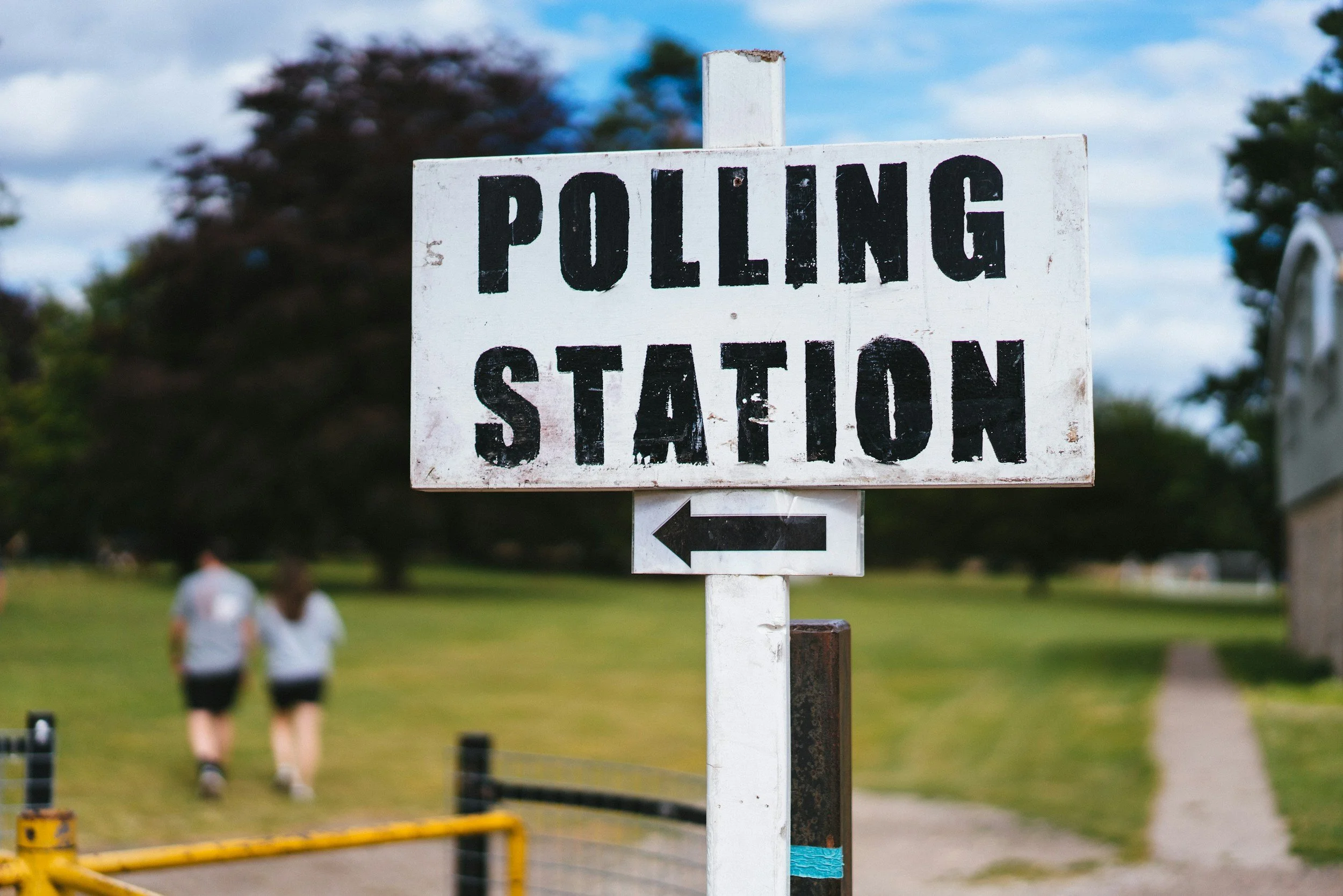Early Voting has begun in New York State!
The election cycle is in full swing in New York. Get your voting information here.
If you haven't voted yet - consider voting early - today!
New York’s early voting period is October 26 through November 3rd this year. If you haven’t found time to request your absentee ballot and are worried about making it to the polls on Election Day, early voting might be a great option for you. Voting early ensures that nothing stands between you and the ability to make your voice heard.
To learn more about ballots, registration and other voting information, click one of the following links:
For Clinton County residents: Clinton County Board of Elections | Clinton County New York
For anyone, including Clinton County residents: Register to Vote: Absentee Ballot Request & Voter Registration Services
U.S. Vote Foundation joins thousands of organizations across the country to celebrate Vote Early Day 2024. Over 220 million Americans have the option to vote ahead of Election Day, by mail or in person. If you’re planning to vote in person, we encourage you to celebrate your right to vote by casting your ballot early.
Congratulations on your new job!
Congratulations, Jenna McPherson!
We are thrilled to announce that Jenna is moving into the Outreach Specialist position with New York at NCCI!
Jenna, your dedication, hard work, and passion have truly paid off. We can't wait to see all the amazing things you'll accomplish in this new role. Wishing you all the best on this exciting journey!
An Outreach Specialist with New York Connects primarily focuses on:
1. **Providing Information and Assistance**: Offering unbiased information and helping individuals navigate available resources and services.
2. **Community Outreach**: Engaging in public education campaigns and outreach activities to raise awareness about available services.
These roles are essential in ensuring that individuals receive the support they need to live independently and with dignity.
Jenna, your dedication, hard work, and passion have truly paid off. We can't wait to see all the amazing things you'll accomplish in this new role. Wishing you all the best on this exciting journey!
ALERT: Pay Disabled Workers Competitive Wages! End Segregated Workspaces
Image of employees at a computer.
Disabled people deserve to work at the same places and for the same pay as nondisabled people. This isn’t news — but in 2024, some of us are still being paid less than the minimum wage in segregated workplaces. This is called subminimum wage, and it most commonly happens in sheltered workshops. It is discrimination, and it is unacceptable. That’s why we’re advocating for Congress to include the Transformation to Competitive Integrated Employment Act (TCIEA) in the Senate Health, Education, Labor & Pension (HELP) Committee’s workforce markup package.
The Transformation to Competitive Integrated Employment Act (S.533) is a bill that would create competitive integrated employment opportunities for disabled people. A package is when related bills get grouped together. In this case, the HELP Committee’s markup package has many workforce-related bills. We want TCIEA to be one of them! It is more likely to pass as part of a package than it is on its own. We also want more Senators to cosponsor the bill. (Cosponsoring means that a Senator supports a bill. Bills with more cosponsors are thought of as more popular.) Here’s how you can take action:
First, see who your Senators are by entering your state here.
Then, see if your Senators are on the HELP Committee. Check if they are on the member list here.
If either of your Senators is on the HELP Committee, call the congressional switchboard at (202) 224-3121 and ask to be connected to your Senator’s office. You can say “Please connect me to Senator [first and last name]’s office.”
Once you are connected to your Senator’s office, you can use our script:
My name is [your full name], and I am from [your city]. I am a constituent of Senator [Name]. I’m calling to ask Senator [Name] to add the Transformation to Competitive Integrated Employment Act, or TCIEA, to the Senate HELP Committee’s workforce markup package.
TCIEA would help states and businesses provide good jobs for disabled people so that we can be active in the workforce and more financially independent. New Hampshire, Maryland, Vermont, Arkansas and Oregon all show an increase in employment rates for disabled people since they switched from subminimum wage to fairly-paid employment in the community.
Disabled people want to work, and TCIEA would help us meet that goal. I would like to ask the Senator to include TCIEA in the HELP Committee’s workforce markup package, ensure its passage this congressional session, and cosponsor TCIEA if they have not already.
If one of your Senators is not on the HELP Committee, we’ve still got steps you can take. You can call the leaders of the HELP committee, Chair Sanders and Ranking Member Cassidy. Their contact information is:
Chair, Senator Bernie Sanders (202) 224-5141 and
Ranking Member, Senator Bill Cassidy (202) 224-5824.
You can use this script to plan what you will say:
My name is [your full name], and I am from [your city]. I am a constituent of Senator [Name]. I’m calling to ask Senator [Name] to add the Transformation to Competitive Integrated Employment Act, or TCIEA, to the Senate HELP Committee’s workforce markup package.
TCIEA would help states and businesses provide good jobs for disabled people so that we can be active in the workforce and more financially independent. New Hampshire, Maryland, Vermont, Arkansas and Oregon all show an increase in employment rates for disabled people since they switched from subminimum wage to fairly-paid employment in the community.
Disabled people want to work, and TCIEA would help us meet that goal. I would like to ask the Senator to include TCIEA in the HELP Committee’s workforce markup package, ensure its passage this congressional session, and cosponsor TCIEA if they have not already.
Wondering what to expect from a call to your elected officials? Check out this guide to making a call to your Members of Congress. If you can’t make a phone call, that is fine — sending an email will work too! You can find your Senators’ contact information on their websites.
Please call or email as soon as possible! Together, we can increase good jobs for disabled people and end subminimum wage. It’s past time to give disabled workers integrated, equal employment.
Let's Address Home Care Shortages - Tell Legislators to Sign the Home Care Data Transparency Act!
Let’s Address the home care shortage
As we continue to fight for individuals in the independent living community, support is needed to continue services and enhance them were possible. NY Caring Majority is working with other agencies and partners to address ongoing needs, including home care shortages.
We have a new bill, the Home Care Data Transparency Act (A10176 Gonzalez-Rojas/ S9266 May), which would require the state to make public a range of data about Managed Long Term Care. As we continue to make the case against private insurance in Medicaid-funded home care, we need to be able to track where the money goes.
Please contact your legislators and ask them to sign on to the Home Care Data Transparency Act.
Click here to look up your state senator and assemblymember and their contact info (click your legislator’s name and then scroll down to see their phone number!)
Script:
My name is [YOUR NAME] from [YOUR ADDRESS]. I’m calling to urge [NAME OF LEGISLATOR] to co-sponsor the Home Care Data Transparency Act (A10176/S9266). This bill would require the state to publish home care data it already collects. Amid an ongoing home care shortage, New Yorkers deserve transparency on basic home care data. For too long, aging and disabled New Yorkers have been left in the dark without access to basic information, including how much is spent on home care, how many home care hours are used, and who is going without services.
By shedding light on these metrics, New Yorkers will have the information and resources needed to understand how the state is providing home care services.
As our population ages and more New Yorkers turn to home care, we need clarity and transparency on this data so we can solve the home care shortage — and that starts with passing this transparency bill immediately. Can I count on [NAME OF LEGISLATOR] to sign on as a co-sponsor of A10176/S9266.
Please contact your legislators and ask them to sign on to S9266/A10176 immediately. For more info on the bill, read below.
What the Home Care Data Transparency Act does
Requires the state to make public a range of data about Managed Long Term Care. This data would:
Allow the public to determine whether the MLTC program is spending taxpayer money as intended:
How many people are enrolled in each Managed Long Term Care plan
What services people receive (for instance, what percent of MLTC spending goes to home care vs other services)
How many home care hours MLTCs are providing
Allow the public to understand how much profit MLTCs are keeping:
How much MLTCs are spending on home care hours vs. how much money is kept as profit
Show service denials:
Number of complaints filed for service denials - showing whether plans are wrongfully denying services
Show nursing home diversions:
How many MLTC enrollees wind up in nursing homes
One of the major purposes of the MLTC program is to keep people out of nursing homes and allow them to thrive in their communities. This data will help the public understand whether MLTC plans are achieving this mission.
New York's 2025 Budget Makes Big Changes to the State's Consumer Directed Program It by Joyce Famakinwa
Big changes are coming to the Consumer Directed Personal Assistance Program in 2025.
Last month, the New York state budget for 2025 passed. It will bring on sweeping changes for home care stakeholders and recipients in the state.
The budget makes major changes to New York’s Consumer Directed Personal Assistance Program (CDPAP).
Under New York’s CDPAP, individuals seeking care are allowed to hire a caregiver of their own choosing. This often means informal caregivers. These caregivers are paid for their services through the program.
The most notable change the budget makes to CDPAP is that it will designate one statewide fiscal intermediary to oversee the program.
Some of New York’s home-based care providers — AccentCare is one example — serve as fiscal intermediaries (FI).
“Our providers really feel like the state is trying to dig a hole with a grenade,” Kevin Wade, a vice president at Sandata, told Home Health Care News. “The state takes the perspective that there’s significant fraud, waste and abuse within CDPAP. They feel that by moving to one, singular FI, they can reach $200 million worth of savings. A change like this adds an additional layer of complexity to an already complex system.”
Sandata is a technology company and an electronic visit verification provider. It works with states, home-based care providers and MCOs.
Wade noted that there were likely other steps the state could’ve taken to help reduce fraud, waste and abuse that would not have upended the current system.
“There are ways to monitor and oversee programs without necessarily altering or transforming the way that care is delivered,” he said.
There are also many questions about how having one statewide FI would work in practice, according to Wade.
“There’s a lot that’s still to be figured out with one singular FI, in terms of how many subcontractors will be allowed within a given area,” he said. “We know that there’s going to be at least one subcontracted FI per rate setting region, so there’s four within New York State. But past that, it’s not known. We don’t know who this fiscal intermediary would be.”
Wade also pointed out that moving from hundreds of FIs to one could impact care, as many of the providers that serve in this role are entrenched in the communities they operate in.
Aside from changes to CDPAP, the budget included a minimum wage increase for home care workers, and Medicaid rate increases for hospitals, nursing homes and assisted living communities.
Say No to Subminimum Wage for Disabled Workers!
Learn more about subminimum wage
The American Dream often consists of finding a good job, having a roof over your head, enjoying friendships and fulfilling community relationships, and engaging meaningfully in activities each day. People with disabilities1 have more opportunities to achieve this dream than ever before, thanks to the nearly 34-year-old Americans with Disabilities Act (ADA), and a series of other federal and state laws and regulations that have created a more equal system of rights. Equal opportunity, full participation, and independent living—three of the four goals of the ADA—seem more like realities for many than in decades past.
Yet, the final goal of the ADA, economic self-sufficiency, still remains far beyond reach for many. Despite progress, relics of the past remain cemented in public policy. One such relic is subminimum wage.2 For people with disabilities, this 85-year-old policy is a roadblock to participating fully and equitably in the workforce.
In 1938, Congress passed a law that created a subminimum wage: a rate of compensation that allows employers to pay people with disabilities as little as pennies per hour. Back then, this was applauded as a step forward to provide employment for people with disabilities, but today, the wage and the attitudes that enable it are seen as unjust and backward. Forward-looking states across the country have been taking steps to eliminate the subminimum wage and to change labor policies to support people with disabilities.
Maine is one example. In 2020, Maine passed legislation3 that eliminated the subminimum wage and adopted the Employment First systems framework, which centers on the idea that all individuals, regardless of support need and disability, should participate in competitive integrated employment.4 Maine also enacted a suite of policies, including Medicaid expansion, tax-advantaged savings accounts, and better counseling on employment benefits. It also applied for and received funds through a federal competitive grant program called the Disability Innovation Fund. Maine now ranks as a top state in the nation for promoting employment for disabled people.
Maine is not alone. Although the subminimum wage policy is often kept in the shadows, for those that know it well, it has been reported on, advocated for and against, been the subject of several Government Accountability Office (GAO) reports in recent years, and largely scrutinized. Despite this attention, few, if any, analyses have been conducted at a national scale to understand the state of the subminimum wage in all 50 states plus the District of Columbia (DC). Data from the Wage and Hour Division of the U.S. Department of Labor (DOL), though available, is inconsistent, cannot be tracked longitudinally, and is only useful when considering how it applies to employers’ use of certificates for a section of the antiquated 1938 law known as 14(c). Those looking to better understand this issue often run into roadblocks when seeking deeper analyses or research.
This report examines, state by state, the policies that drive the use or elimination of subminimum wage, as well as the programs each state provides to more comprehensively support individuals with disabilities as they seek meaningful employment and fair wages. Analyzing and comparing policies across all states allows for a national perspective on the drive to eliminate the subminimum wage. It also highlights other employment-related policies used to support individuals with disabilities. We hope our report not only provides an opportunity for stakeholders to dive into their own state’s policies and practices but helps map out best practices. Whether it is Maine or Mississippi, Oregon or Iowa, our analysis offers evidence of sweeping and often surprising progress. States around the country, blue and red, rural and urban, are making significant headway in lasting ways, leading to an improved quality of life and competitive integrated employment for disabled workers in the United States.
Authored by Lillie Heigl, Kimberly Knackstedt and Elena Silva
Learn more about Medicaid with this virtual "tea time" chat!
Medicaid Matters New York will now host a monthly Tea Time Chat! On the second Tuesday of every month at 7pm, we will host this dedicated time for people who have Medicaid for their health insurance coverage to come together in an evening Zoom meeting. Our first monthly chat will take place this coming Tuesday, May 14th at 7pm. Register here !
When you complete the Zoom registration, you will be registered for each of the monthly evening meetings.
To learn more, go to Medicaid Matters | NY (medicaidmattersny.org)










